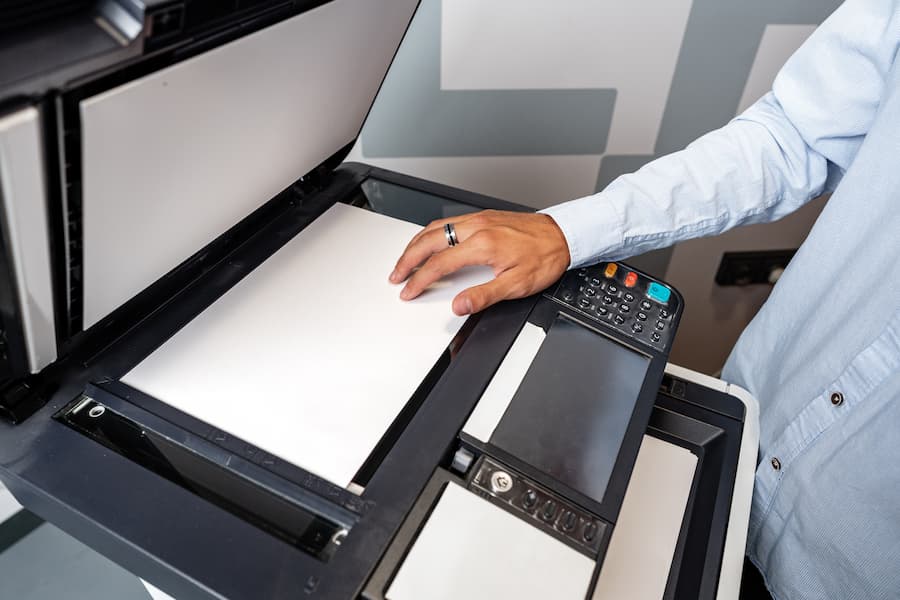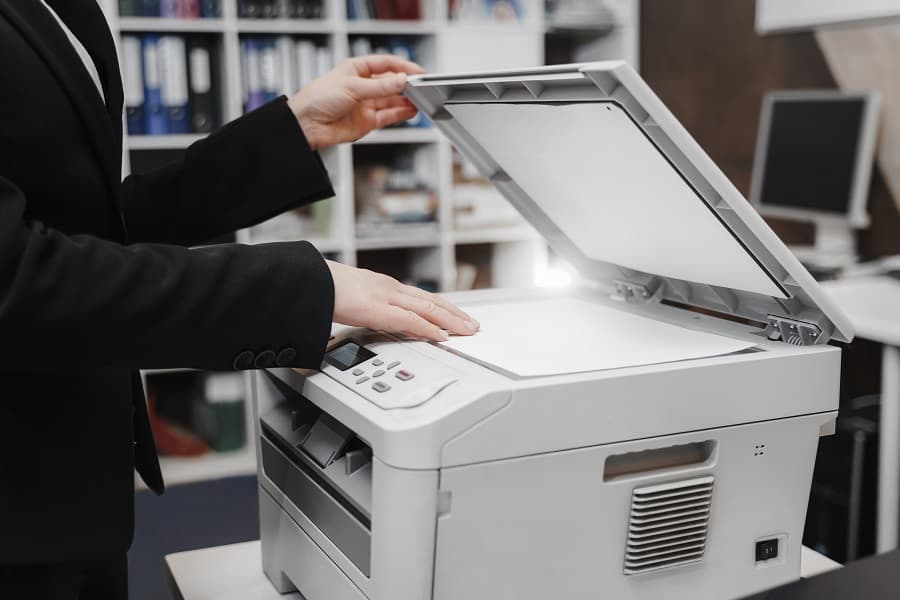Common Uses for an Office Scanner in 2024
Common Uses for an Office Scanner
The journey of the office scanner has been nothing short of revolutionary. From bulky machines to sleek, digital conduits of information, scanners have become indispensable in the modern office. In 2024, their role extends far beyond mere image capturing.
Office scanners now serve as vital tools for digitizing, archiving, and sharing documents, streamlining workflows in an increasingly paperless world. Their evolution reflects a broader shift towards efficiency and sustainability, making them more than just office equipment—they’re a cornerstone of modern business practices.
What Is an Office Scanner?
An office scanner is an essential piece of technology that transforms physical documents into digital formats. Predominantly utilized in business settings, these scanners are adept at handling documents of various sizes, making them a flexible tool for digital document management. You’ll find that some scanners are compact enough to fit on a desktop, offering convenience and efficiency without occupying too much space.
Meanwhile, others are part of multi-functional printers (MFPs), or “all-in-one printers,” which might require more room but provide a comprehensive suite of functions beyond just scanning. This integration into MFPs underscores the scanner’s role in modern office ecosystems, streamlining operations by merging several devices into one.
Uses for an Office Scanner
Copying Documents
The ability to digitize and edit documents before printing is crucial. Scanners offer a versatile solution, transforming paper documents into digital formats with ease. This process not only saves time but also enhances document management.
For instance, after scanning an invoice, you can edit the document to correct any errors or update information before sending it out. This flexibility is a testament to how scanners streamline office operations, making them a fundamental part of the document workflow.
Digital Archiving
Scanners play a pivotal role in document archiving, ensuring that vital records like tax paperwork, business records, and personal documentation are preserved in digital format. This not only safeguards information from physical degradation but also optimizes storage space.
By converting paper files into digital copies, businesses can easily retrieve, manage, and secure their documents.
Research
For research endeavors, scanners are indispensable tools. They allow researchers to digitize information from various sources, ensuring that no valuable insight is lost. This capability is particularly valuable when dealing with borrowed materials or rare documents that cannot be easily accessed.
By scanning these resources, researchers can maintain a comprehensive digital library, accessible anytime, enhancing both efficiency and the depth of their work. In other words, scanners bridge the gap between physical documents and digital exploration, enriching the research process.
Sharing and Collaboration
The ability to share documents electronically has become a cornerstone of collaboration. Scanners facilitate this by converting physical documents into shareable digital formats. Whether it’s a business plan, a creative project, or important meeting notes, scanned documents can be distributed instantly across teams, regardless of geographical barriers. This connectivity not only speeds up decision-making but also fosters a collaborative culture, making it easier for teams to work together towards common goals.
In conclusion, the multifaceted uses of office scanners—from copying documents to fostering collaboration—underscore their integral role in modern business operations. As we move further into the digital era, the importance of these devices in enhancing efficiency, safeguarding information, and supporting collaborative efforts continues to grow. Scanners, with their ability to digitize, archive, and share, are not just tools but essential partners in the quest for a streamlined and productive workplace.
Advanced Functionalities of Office Scanners
Medical Scanning
Technologies such as CT (Computed Tomography) and MRI (Magnetic Resonance Imaging) are pivotal in diagnosing and monitoring health conditions. These scanners produce detailed images of the inside of the body, helping medical professionals identify abnormalities like tumors or fractures. Therefore, the use of scanners in healthcare not only facilitates early detection of diseases but also guides treatment plans, underscoring their critical role in patient care.
Handwriting and Signature Scanning
The banking, legal, and educational sectors increasingly rely on scanners for document authentication and verification. Handwriting and signature scanning technology enables the digitization of signatures and handwritten notes, ensuring their authenticity.
This application is crucial in preventing fraud and maintaining document integrity. For instance, banks use this technology to verify signatures on checks and contracts, while legal and educational institutions digitize important documents for record-keeping and analysis.
Engineering and Architectural Scanning
In engineering and architecture, scanners support the creation of 3D models and detailed documentation of structures. These scanners capture the physical dimensions of objects and spaces, converting them into digital models that can be manipulated and analyzed.
This process is essential for planning, design, and renovation projects, allowing professionals to visualize changes and make precise adjustments before any physical work begins. In addition, these scanners streamline the workflow, making the planning process more efficient and accurate.
Passport and ID Scanning
The use of scanners for passport and ID verification is widespread across various industries, enhancing security and streamlining the identification process. These scanners quickly authenticate personal documents, ensuring that individuals are who they claim to be.
This technology is particularly important in border control, banking, and hospitality, where verifying a person’s identity is crucial for safety and service. By digitizing and verifying personal documents, scanners help prevent identity theft and fraud, contributing to a safer and more secure society.
Technological Advances and Features
Types of Scanners
Today’s market offers a variety of scanners, each designed for specific needs. Flatbed scanners, ideal for quality scans of documents and photos, feature a glass pane and a moving scan head. Sheet-fed scanners, efficient for high-volume document scanning, pull documents through the machine.
Portable scanners offer flexibility for on-the-go professionals, while 3D scanners capture complex shapes for modeling and design. This diversity ensures that whether you need to scan a single business card or create a 3D model, there’s a scanner that suits your needs.
Resolution and Quality
The resolution of a scanner is measured in DPI (dots per inch), indicating the detail level of the scanned images. High-resolution scanners are capable of capturing more detail, making them ideal for scanning photographs or intricate designs. However, for standard document scanning, a lower resolution may suffice.
The choice of resolution impacts the clarity and usability of scanned images, affecting everything from the ability to zoom in on details to the quality of prints. Therefore, selecting a scanner with the right resolution is crucial for meeting your specific scanning needs.
How to Choose a Scanner for Your Office
Selecting the right office scanner can seem overwhelming with the myriad of brands, sizes, and styles available. The most effective approach is to engage with a Managed Print Services (MPS) provider who has the expertise to perform a thorough needs assessment.
This process will help clarify your document scanning requirements, including what you’ll be scanning, when, and how often, enabling the MPS provider to tailor a recommendation that suits your specific needs.
Here are a few key factors to keep in mind during your search for the perfect office scanner:
- Network and Software Compatibility: Ensure the scanner integrates seamlessly with your current systems.
- Scanning and Imaging Features: Look for a scanner that offers the scanning and imaging capabilities necessary for your tasks.
- User-Friendly Controls: Choose a scanner with intuitive controls for ease of use.
- Office Space Fit: Consider the physical space you have available and select a scanner that fits.
- Batch Printing Capability: If you frequently need to print large volumes of documents at once, make sure the scanner supports batch printing.
By keeping these considerations in mind, you’ll be well on your way to finding an office scanner that not only meets your needs but also enhances productivity and efficiency within your workspace.
Benefits of Office Scanners
- Time Efficiency: Quickly locate documents in an online database rather than navigating through physical paper stacks.
- Space Conservation: Utilize less office space compared to bulky filing cabinets filled with paper documents. Consider integrating scanning capabilities in your next MFP contract.
- Boosted Productivity: Employees can access data electronically without interrupting customer interactions, enhancing efficiency.
- Remote Accessibility: Allows off-site employees to access documents as easily as their on-site counterparts.
- Enhanced Security: Digital documents with restricted access improve confidentiality and security measures.
- Disaster Recovery: Easier data recovery from backups stored offsite or in the cloud, minimizing downtime in emergencies.
- Organizational Transparency: Facilitates document sharing among authorized users, supporting security and teamwork.
- Damage Prevention: Protects against physical document damage from spills, aging, or wear.
- Environmental Benefits: Scanning reduces paper use and waste, contributing to a smaller carbon footprint for the organization.
What People Also Ask
What are the common uses for an office scanner?
Scanning documents for digital storage, sharing, and editing; archiving paper documents; and converting physical documents into editable formats.
Can office scanners scan to PDF?
Yes, many scanners and scanning software support direct scanning to PDF format, making documents ready for distribution and archiving.
Do scanners come with OCR (Optical Character Recognition) software?
Many scanners include OCR software, enabling the conversion of scanned images into searchable and editable text.
What types of documents can I scan with an office scanner?
Office scanners can handle a wide range of documents, including invoices, contracts, business cards, and more, in various sizes.
Conclusion
Scanners have evolved into sophisticated tools that play a crucial role in modern business operations. From medical diagnostics to document management and security, the advanced functionalities of office scanners streamline processes and enhance productivity.
With a variety of types available, businesses can choose the scanner that best fits their needs, ensuring efficient and effective document handling. As technology advances, scanners will continue to be an essential component of office equipment, facilitating a seamless bridge between paper documents and digital workflows.














